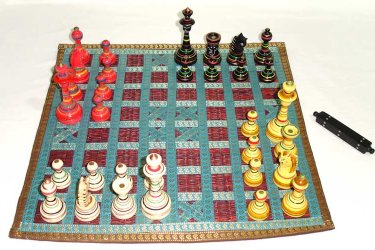Four-Handed Chaturanga a.k.a Chaturaji
For many people, the eldest ancestor of Chess is an Indian game for 4 players, 4-Handed Chaturanga, sometimes called Chaturaji (a Sanskrit word meaning "four Kings"). This game is depicted as a diced game where four teams of 8 pieces fight for a final victory.
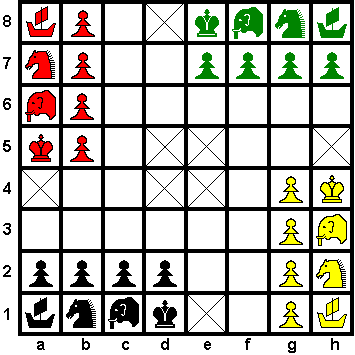
Starting position

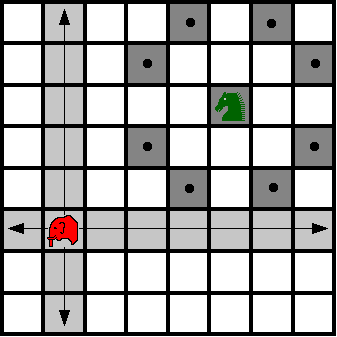
Movements of the pieces
Simplistically, this game is supposed to illustrate a remote period when India was divided into several rival kingdoms, always at war. Later on, a wise man would have come and proposed to gather the pieces in two opposing teams. The extra King per side would have been given the role of a General, the dice would have been eliminated for a pure combination : Chess was born !
This is a seducing story. Simple, understandable, bearing some logic. This story is so nice that it is now widely repeated and copied on hundreds of pages on the Internet. But,
|
CAUTION: THIS THEORY HAS NO PROOF AND IT IS CERTAINLY WRONG! |
HOW IT BEGAN :
Sir Williams Jones (who first remarked the links between Indo-European idioms), reported in his book "On the Indian Game of Chess" (1790) the tale saying that Chess had been invented by the wife of Ravan, king of Lanca (Ceylon), in order to amuse him while he was besieged in his city by Rama. This was happening in the "second age of the world", in the 4th millennium before Christ! His informant was the brahman Radhakant who was referring to the Four-Handed Chess (which was played in India until the 19th century), apparently evoked in a Sanskrit text, the Bhavishya Purana.
However, Jones considered the 4-Handed game as a modification of a primitive 2-Handed non-dice Chess. But this intituition was swept by Captain Hiram Cox, an English officier of the British East India Company, Governor of Bengal, who asserted in 1801 that it was 4-Handed Chess which was the seminal game and the 2-Handed game was a modification of it.
Duncan Forbes, a British linguist, adopted Cox's idea in his The History of Chess (published in 1860) where he developed the complete theory: a primitive 4-Handed dice-Chess was practiced first, and, from the difficulty of always finding four players, the game gradually became 2-Handed. Later on, the dice were abandoned, maybe under religious pressure. Forbes did not endorse the legend of Lanca, however he affirmed that 4-Handed Chess was described in the Bhavishya Purana, a sacred text that he estimated to be 3000 or 5000 years old. This is what is called the Cox-Forbes theory now.
However, the German indianist Prof. Albrecht Weber and the Dutch historian, Anton van der Linde, pointed out in 1874 that the Bhavishya Purana was not that old and that they contained no reference to Chess (which was confirmed few years later when this Sanskrit text became available to European scholars). This was too hard to believe for authors like Edward Falkener (1892) who was convinced of a very great antiquity. Also, the famous American ethnologist Stewart Culin made his personal hypothesis (1898) that the respective apparition order of board-games in mankind history should have been : race game for 2, then race game for 4, then chess for 4 and, finally, chess for 2. Culin had no fact to support this thinking, just his intuition.
Having doubts, the American Professor Willard Fiske wrote in 1900: "Before the seventh century of our era, the existence of Chess in any land is not demonstrable by a single shred of contemporary or trustworthy documentary evidence... Down to that date, it is all impenetrable darkness." The final word went to the great historian Harold James Ruthen Murray who cleared the question in his never surpassed monument : A History of Chess, more than 900 pages of erudition published in 1913. He demonstrated that the use of dice were never forbidden or discouraged for religious reasons in India where, on the contrary, representation of gods and goddesses playing are numerous. Relying on Weber's work, Murray confirmed that the Bhavishya Purana (composed at the earliest on the 3rd century B.C.) nor any other Purana contains any reference to Chess.
He concluded that (p49):
" the silence of all other Sanskrit works before 600 A.D. makes Radhakant's assertion improbable in the highest degree".
Concerning Culin's argument about Chess coming from an evolution of a race game, Murray revised it politely and, finally, wrote that definitive sentence (p50): "I find this hypothesis incredible".
THE STATUS OF OUR KNOWLEDGE :
Three Indian texts refer to the passage cited by Jones and Forbes. It has been demonstrated that the three of them go back to same sources, two Bengalese texts from the late 15th or early 16th century: Raghunandana's Tithitattva and Shulapani's Chaturangadipika (both being contemporary and linked if not copied). Clearly, Forbes was wrong. All details on which all descriptions rely are then about less than 500 years old only.
As the matter of fact, the earliest account of the 4-Handed Chess is an Arabic work, the Tahqiq ma li l-Hind, a travel account in India by the famous Persian poet al-Beruni, written circa 1030. (Al-Beruni was born at Khiva in 973, lived at Hyrcania on the shore of the Caspian see and died in 1048). But his rules are not always clear. Most of the details we know on the rules come from Raghunandana.
After al-Beruni, there are two Indian texts mentioning the 4-Handed Chaturanga which are older than the Tithitattva: Someshvara's Manasollasa circa 1110 and Kalhana's Rajatarangini, a metrical chronique of the Kings of Kashmir, dated 1148-9. However, those mentions are very short. Someshvara III was a prince of South-West India. His text is much more detailed for the regular 2-Handed Chess, showing that 4-Handed Chess was a mere variant at his time.
To be exhaustive, there is an other testimony of 4-Handed Chess and it comes from ... Spain! Indeed, the Libro de los juegos, a codex composed in 1283, attributed to Alfonso X, King of Castille, mentions "Four Seasons Chess", a Chess for 4 players. The rules a somewhat different from the Indian ones. This game also used dice.
|
In short, the earliest reference for a 4-Handed Chess comes from the 11st century only whereas the earliest mention of 2-Handed Chess is dated from early 7th century, so more than 400 years before! |
COMMENTS :
The oldest reference for this 4-Handed game is 1030 only. In the 11th century, the 4-Handed appears to have been known and practiced in India only. If it had been the ancestor of the 2-Handed form, it will have yet to be explained why it was not transmitted to other neighboring peoples and why all sources, literal or archaeological, are silent before, over such a long period of more than 400 years.
It is true that Indians did not pay much attention in writing the rules of their games as the Persians or the Arabs did. There is a small number of Sanskrit texts which mention Chaturanga in India before 1000, but none clearly state what was the number of players.
Al-Adli, an Arabic master who wrote about 840, gave the difference between the rules and play of Chess in India versus the ones he knew in his country. He gave them in deep details, and his observation always concerned 2-Handed Chess. Al-Adli has not mentioned any 4-Handed Chess in India. If it existed, it escaped his attention, which would be surprising.
The fact that the 4-Handed Chaturanga makes use of dice has been often emphasized to assess its supposedly great antiquity. However, this is not a sound argument at all. In those medieval times, Chess was not that model of pure combination that it is today. The game was slow and boring. Old times masters were more attracted by theoretical problems (openings, endings) than real plays. Playing with chance was not a shame, it represented destiny. The success of games like Nard (kind of Backgammon), Pachisi, Caupur and many other Indian games are here to testify that. Nard was at its summum of popularity in India between the 7th and 10th centuries, and the Indian cruciform race games (Pachisi, Caupur) could been invented at the same period. Then, it is not surprising that a game for 4 were more appreciated with the help of dice to add some drama into the play. In addition, it should be insisted that Chess and dice were not incompatible. Muslims played Oblong Chess (over a 4x16 board) with dice, dice were often used in medieval Europe as an alternative of the regular play (for instance in Huon de Bordeaux, a French romance from the 13th century, or in the Alfonso X's Libro de los Juegos in 1283. On the opposite, when the Manasollasa mentions 4-Handed Chess, it is said that this game is played without dice. Therefore, there is no exclusive relation between 4-Handed Chess and dice, and playing with Chess with dice is not a character of a greater antiquity.
Another original aspect of 4-Handed Chaturanga has been put forward, again to assess his antiquity: the use of Ships instead of Chariots and their switched positions with the Elephants, here placed at the corners of the board. However, placing Elephants in the corner and the piece with the Rook move close to the King is merely the reflect of Chess habits in India and is in complete line with the situation of 2-Handed Chaturanga. The use of Ship (Nauka) is only accounted in Raghunandana's Tithitattva which comes in the late 15th century only. Al-Beruni had a Chariot (Rook). This is probably a consequence of the use of Arabic style piece were the Rook was depicted with a large "V" slot, which could be interpreted as a boat shape. Nauka has been often used later, in Bengal especially (the Tithitattva is written in Bengali). The use of Ship is also effective in 2-Handed Chess in Bengal (as well as in Thailand, Cambodia and Java).
Finally, it is worth to point out that there is a true attraction in India for 4 players games. It would be interesting to search if this can explained the birth of Pachisi from Nard which might be contemporary of the apparition of Four-Handed Chaturanga in the last centuries of the first millennium.
|
Murray's opinion is still the most probable : the 4-Handed Chaturanga has been an Indian local variant of the regular 2-Handed game |
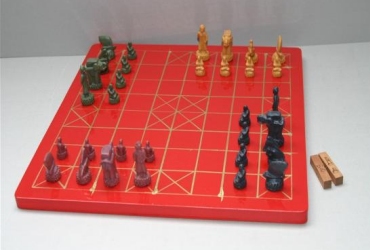
A nice modern reconstruction
from the French CCI website
(caution recommended with the accompanying text)
Even today, there is not a single
evidence in favor of the ancestry of the 4-Handed
Chaturanga. This theory only lies on some 19th century
mistakes. It should be abandoned. It is generally the case
in serious English books and literary studies.
Surprisingly, the wrong theory is surviving in a lot - too
much - of French literature about Chess and Indian
civilization, even though when those books are of very
high quality and can be used as references for other
points. This is really a pity with sad consequence as with
Internet a lot of websites badly informed are now
flourishing.
Find the rules of Four Handed
Chaturanga
on chessvariants.com
NOTE TO READERS:
Even after years of researches in the field of history of Chess, I am sometimes surprised of how big can be the trouble for some readers about what I present on this page.
Some people refuse to recognize the facts because they believe to know that the earliest Chess was 4-Handed and diced from long time: they know because they had read it somewhere in a book, a newspaper or on the www or anywhere else. Some may have esoteric reasons based on what they believe to be ancient philosophy, magic of the number, ... this kind of things. Then, sometimes, I'm getting messages, e-mails, phone calls. They are not always nice.
I am OK to answer any request from someone not familiar with the field and having questions or wanting to clear something.
I am OK to discuss with more specialized readers wishing to go deeper into the matter. If you have or know any elements I would ignore, I would love to learn this. I am looking for facts, historical or scientific.
I am not OK to engage a discussion with people in search of controversy for controversy. I am not OK to discuss with people who are in search of recognition and take pleasure to attack me with irony or mockery, not supported by serious elements. Unrespectful people will not be answered.
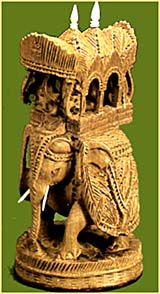
An Indian Elephant






